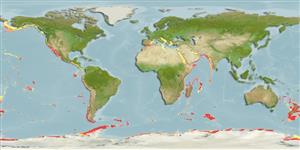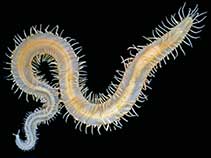Trypanosyllis gigantea (McIntosh, 1885)
| Native range | All suitable habitat | Point map | Year 2050 |

|
| This map was computer-generated and has not yet been reviewed. |
| Trypanosyllis gigantea AquaMaps Data sources: GBIF OBIS |
Classification / Names Common names | Synonyms | CoL | ITIS | WoRMS
Polychaeta | Phyllodocida | Syllidae
Environment: milieu / climate zone / depth range / distribution range Ecologia
; intervalo de profundidade 54 - 926 m (Ref. 107177). Tropical
Distribuição Países | Áreas FAO | Ecossistemas | Ocorrências | Introduções
Indo-Pacific, Mediterranean Sea and the Antarctic. Tropical to polar.
Length at first maturity / Tamanho / Peso / Idade
Maturity: Lm ? range ? - ? cm
Life cycle and mating behavior Maturidade | Reprodução | Desova | Ovos | Fecundidade | Larvas
Members of the class Polychaeta are mostly gonochoric (sexual). Mating: Females produce a pheromone attracting and signalling the males to shed sperm which in turn stimulates females to shed eggs, this behavior is known as swarming. Gametes are spawned through the metanephridia or body wall rupturing (termed as "epitoky", wherein a pelagic, reproductive individual, "epitoke", is formed from a benthic, nonreproductive individual, "atoke"). After fertilization, most eggs become planktonic; although some are retained in the worm tubes or burrowed in jelly masses attached to the tubes (egg brooders). Life Cycle: Eggs develop into trocophore larva, which later metamorph into juvenile stage (body lengthened), and later develop into adults.
Referência principal
Referências | Coordenador | Colaboradores
Sicinski, J. and P. Gillet. 2002. (Ref. 87389)
Status na Lista Vermelha da IUCN (Ref. 130435: Version 2024-1)
Status no CITES (Ref. 108899)
Not Evaluated
CMS (Ref. 116361)
Not Evaluated
Perigo para os humanos
Uso pelos humanos
| FishSource |
Ferramentas
Mais informação
Trophic Ecology
Itens alimentares
Dieta
Consumo alimentar
Ração
Predadores
Dieta
Consumo alimentar
Ração
Predadores
Ecology
Population dynamics
Crescimento
Idade/Tamanho
Comprimento-peso
Comprimento-comprimento
Frequências de comprimento
Mass conversion
Recrutamento
Abundância
Idade/Tamanho
Comprimento-peso
Comprimento-comprimento
Frequências de comprimento
Mass conversion
Recrutamento
Abundância
Life cycle
Distribution
Human Related
Perfil para aquacultura
Stamps, Coins Misc.
Stamps, Coins Misc.
Outreach
Taxonomy
References
Fontes da internet
BHL | BOLD Systems | CISTI | DiscoverLife | FAO(Publication : search) | Fishipedia | GenBank (genoma, nucleotídeo) | GloBI | Gomexsi | Google Books | Google Scholar | Google | PubMed | Árvore da vida | Wikipedia (Ir para, procura) | Registro zoológico
Estimates based on models
Preferred temperature
(Ref. 115969): 1.4 - 17.3, mean 12.9 (based on 464 cells).
Categoria de preço
(Ref. 80766):
Unknown.



